Dan Herschlein is a Brooklyn-based artist that creates physical and emotional scenarios drawn from both horror tropes and his own upbringing in suburban Long Island through various mediums including sculpture, installation, and drawings. Recently, he curated Beside Myself, a group exhibition for JTT Gallery, was included in Pine Barrens at Tanya Bonakdar, and was chosen to occupy the storefront windows of the New Museum, which will be up until January. Jongho Lee from Eyes-Towards-The-Dove met with Dan at his studio to discuss these recent events, as well as his studio practice and gallery, among other things.
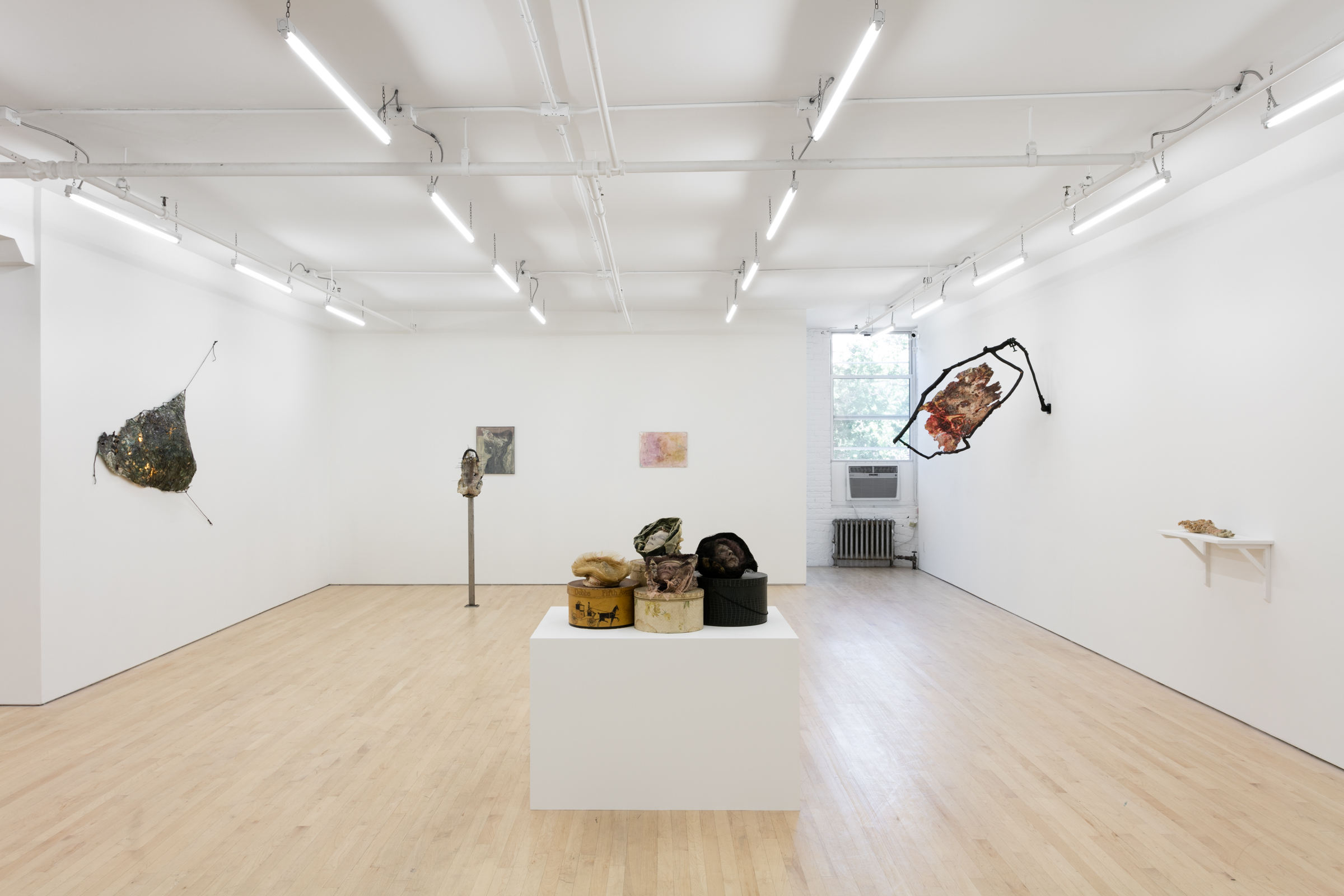
Jongho Lee: I wanted to start with your busy summer- was this your first time curating a show?
Dan Herschlein: It was my second time, but the first time was a one-night pop up. So that was my first time, but it wasn’t even that different. For the first one, I wrote a press release too, even though it was just a little show within a show.
JL: And you handled the press release, the curation of artists, with the gallery was just the setting for this? Or did they have a bigger part in curation?
DH: I definitely talked to them a lot, but they didn’t make any ultimate decisions. They set the parameters that I could work within. For example, I was able to get one work shipped from outside of New York, so I could do whatever I wanted within reason. That work ended up being Nancy Youdelman’s works, which was probably the most important piece in the show. It was amazing to get those pieces. That all feels so long ago.
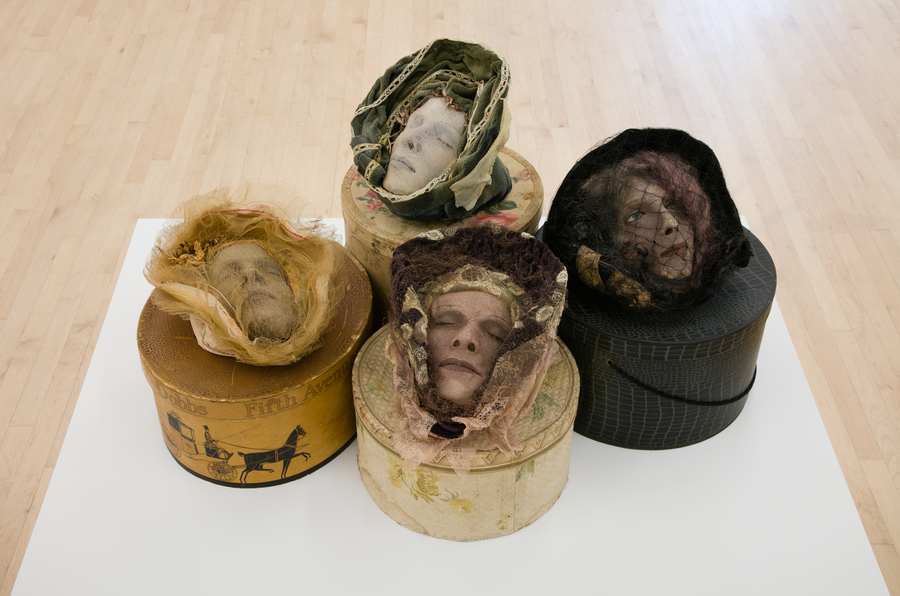
JL: The show resonated elements of your practice. Was that intentional?
DH: Yes. I was reading all these works by Kaja Silverman and this other theorist Mark Fisher. Kaja’s more of a psychoanalytic type of theorist- she goes through Lacan and talks about the mirror stage and the ongoing mirror stage that people go through- how we are constantly consuming images of types of people and trying to incorporate that to figure out who we are on a daily basis. She then talks about all the damaging effects of that- looking at the way people are portrayed. She also proposes that art is the way to combat that, by producing more images that counter the normative versions of people. You can flood the plane and give a better pool to pick from.
JH: Is that where the title, Beside Myself come from?
DH: Exactly. It’s the image of yourself beside yourself, the construction of your ego. That’s a lot of the stuff that I think about, but I think about it in terms of maleness and masculinity and maybe in a suburban context, which is where I grew up. But in that show, I saw all these other artists who even though they weren’t all talking about that, they were clear examples. They weren’t all dealing with the same things that I’m dealing with, but it was interesting to create a scenario where I’m not telling you what they’re doing exactly, or what they’re feeling is. That was really hard to navigate, trying to organize a show that felt cohesive but not to speak for people.
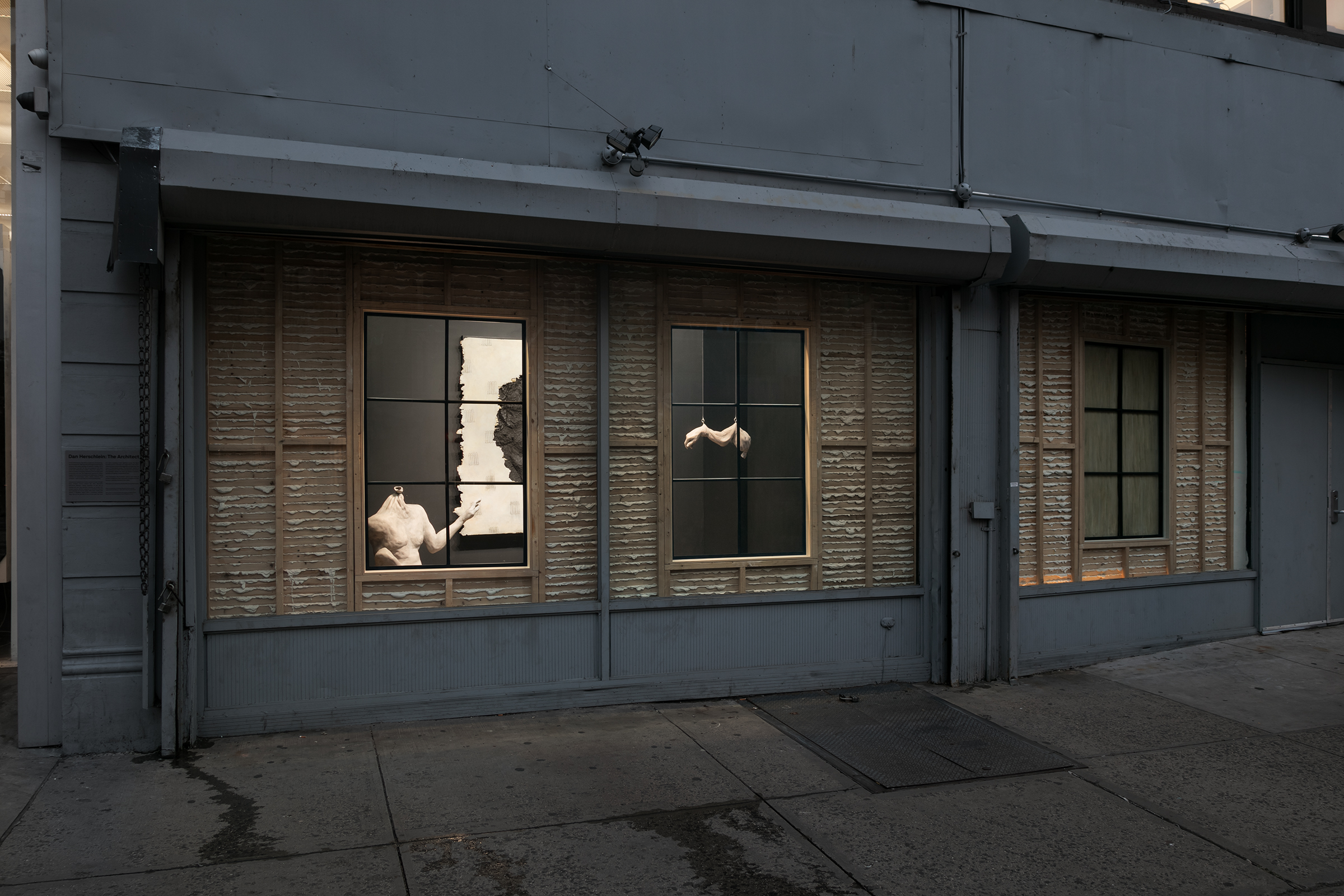
JH: A few months later The Architect opened at the windows of the New Museum. Were you working on curating the exhibition and this at the same time?
DH: I found about that project in the middle of putting together the group show. I was brainstorming while I was curating it, but didn’t actually start physically working on it until after the opening.
JH: Was it challenging to work with a space that had the vocabulary of a display window baked into it?
DH: It was super fun. That’s my favorite thing to do, to have a site specific challenge in that way. It was also important that I not make a display window- to make it somewhere between a stage set and also think about all the relief pieces I’ve been making. They’re pretty low relief, but using that logic to turn a space thats 6 or 7 feet deep into something that’s supposed to be a full size room. There’s a compression that happens that makes it theatrical.
JH: Can you talk about the intertwinement of your life and your art? Even for other artists that draw from personal narrative, there seems the be a link between art and personal life that seems much more blurred in your practice.
DH: Maybe I can talk about in this sense: I’ve been thinking about how much people’s personal stories should play into their works and am interested in the degrees of variation.
For myself, I was thinking about the use value of telling something personal. Especially for the culture of masculinity, something that’s important to me is to make works that have this vulnerability and have an openness to personal stories and feelings. Just the acknowledgment of their existence is important, because that’s something you’re not traditionally taught to do as a “man”. There’s something in acknowledging how strange and volatile feelings can be and the way that I feel I’ve dealt with them in the past has been to have dissociative feelings where an overly emotional situation will reinforce my objecthood.
All I wanted to do as a kid was to disappear or blend into the wall. And that was a defensive thing.
JH: Are you talking about the normative imagery that you talked about earlier? To blend into those images or types?
DH: That’s one way. But the way I personally took it as a child was literally fantasizing about being a piece of furniture.

JH: And a lot of the work deals with memory through architecture and the specificity those memories associated with furniture or interior.
DH: Yeah, I’ve been thinking about voyeurism and how if you’re a voyeur, that is the most absent you can be as a person. You’re a part of the situation, but the only person that knows you’re there is you.
JH: Do you think thats why there’s so much power to being a voyeur?
DH: I don’t know that the voyeur actually is a powerful position. I don’t think that it actually is. I think there are ways in which it’s used as a way to get around something to feel powerful, but it’s not powerful as a position.
JH: Is it a vulnerable position?
DH: I think it’s a cathartic thing. You’re not vulnerable because you’re so absent. You can’t be impacted by anything happening around you. Maybe voyeurism is a misleading way to talk about it, but in a lot of my work there are figures looking through or coming through windows, or coming through doorways, or literally a part of a furniture. There’s a part of that that’s not necessarily about observing the situation because in the instances I mean, it’s just about that character being in that position- being absent while present. It probably doesn’t sound like anything makes sense.
JH: It does, I was just thinking that I’ve always thought of the voyeur being in a more powerful position, but maybe there’s a lack of control to being a true voyeur.
DH: I think there’s confusion between the male gaze and voyeurism. The way voyeurism is depicted is always through a lens of the male gaze. The experience of being a voyeur though, is not one of control.
JH: Right, I was thinking about power in the gaze of the panopticon, and how there’s a lack of control too, because people know they might be being watched.
DH: Right, and the way I took comfort in that idea as a child was not that you could watch somebody do something, but that you were in a position to make sure no one could see you. It’s more about being hidden. The actual act of spying is more of a defense mechanism in the way that I’m setting it up for myself.
I’m also thinking of melodramatic images of a house where you see someone standing in a window. Maybe they don’t see you standing there, and they feel ultimate the most alone in that window.. They feel like they can see anything else that might be able to see them, but there’s something about that relationship of being on a threshold where you can see something beyond it. That doesn’t have to be predatory. I think that tension is what I am trying to play with.
I’m using the language of horror a lot, because that’s where it comes up a lot. But in that mise-en-scène of horror, I’m trying to reintroduce comfort and make it a space where you can sit with something dark and just feel it. I think that’s something that’s important- just feeling things. There’s definitely a lot of things about self-comforting in my work too. This piece is a good example, I was really trying to hit home with it by calling it “The Comforter” where the curtain becomes a hand that another hand that’s coming through the window is just barely touching. I was also thinking about this De Chirico piece called “The Comforter” with two figures, one seated and one standing next to it with its hand sort of around the shoulder. I was thinking about that, and this one morning when I woke up, I had my hand stretched along the wall behind the dresser and woke up to the feeling of another hand touching my hand. It was a dream, but it felt nice and I realized how strange that was.
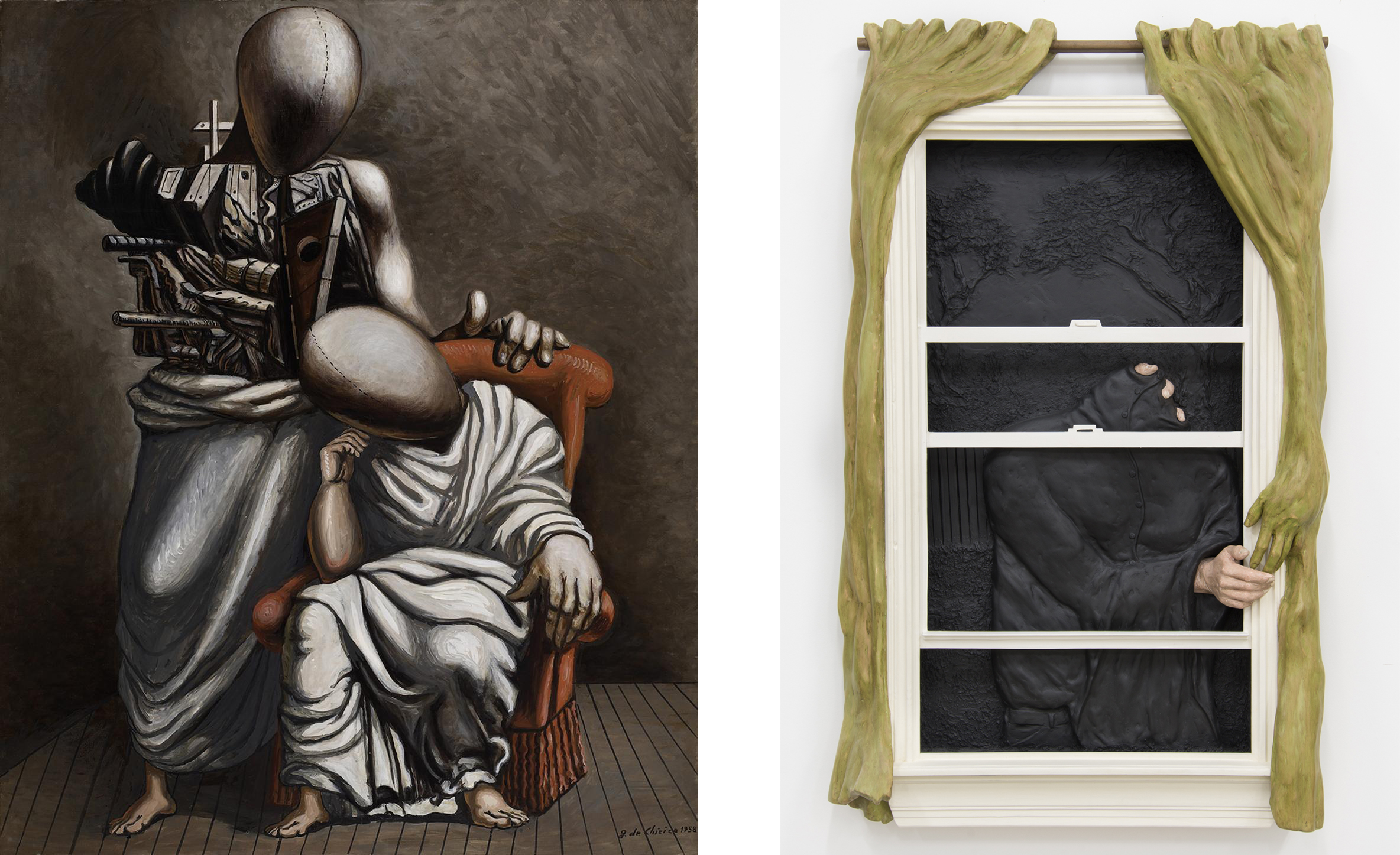
JH: It must be helpful to think through the language of horror with all the great horror movies coming out. When you were describing the scene of the figure in the window, I kept thinking about the characters in Hereditary that stand at edges of the frame just smiling.
DH: There’s so much good horror happening in a fictional sense. Horror definitely gets a bad rap, and I’ve been listening to a lot of interviews by horror writers and directors trying to figure out what it is about horror that gives it that.
JH: Because it can be cheap to make? You can make the best horror movies with the lowest budget.
DH: I think that’s one reason, but it doesn’t have to be that way. Good horror is good story telling with a scare.
JH: I think you can take a lot more liberties in a horror film too, as opposed to other genres.
DH: What horror expresses is also really unclear and it does that in a lot of different ways. Sometimes, it takes a cultural moment and it re-represents that moment in a specific plot. And it’s not as intentional as other genres. I think horror is a more intuitive genre, compared to a straight up drama, for example. Like the way post-911 was really summed up in the movie Hostel. There’s definitely themes of xenophobia, and the fear of the other, but there’s not really a message to it, it’s just an expression of these feelings.
JH: I was talking to a friend about 28 Days Later, and she asked what I thought the zombies meant. When I asked what she meant, she told me about theories of the zombies representing immigration, amongst other things and all those reads can alter the intention and message of the film.
DH: They can be re-read over time too. That’s one thing that I find valuable about horror, and that’s maybe what I mean by its intuitive nature where the way you can represent various number of things with zombies, like immigration, capitalism, technology. It can stand for anything coming from the outside and that happens a lot. But you don’t have to talk about a specific moment or a setting or a person to get that point across and live it out.
I can’t figure out if I believe in things being cathartic. I don’t know if that’s what I like about horror or if that’s something I even believe in.
JH: It seems like you’re drawn to it, whether you believe it or not. It’s something that sticks with you and is in the space you’re working towards.
DH: Absolutely. I’m sure it has something to do with my dad showing me Universal monster movies since I was four, and the fact that I’ve grown up on horror. There’s something very comforting about it for me and I haven’t been able to explain that to myself. But I think the way that I’m trying to work out what I feel is important in my art is by setting up these scenarios that are creepy, and making them something where there can be something loving, or funny in it. Or just something really felt.
JH: What are you excited by other than horror movies? Art or otherwise.
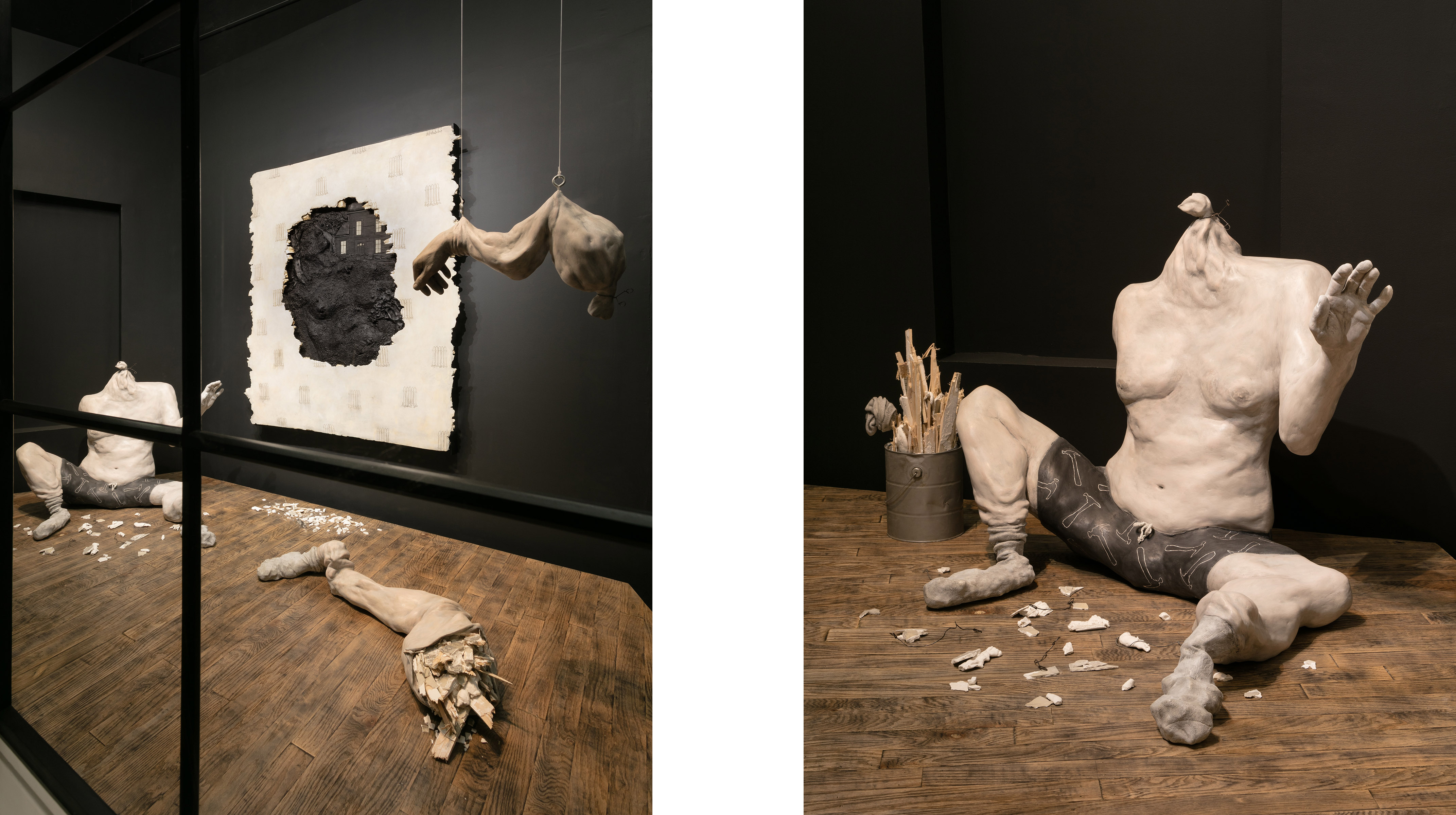
DH: I get excited by a lot of stuff. I really like looking at folk art and folk art objects. I like things that feel very homemade, or where you can tell it was made by the person that made it. That’s the relationship I want between an artist and an art object. That’s also the scenario I want to imagine, the space of making. That’s another thing that comes up in my work too. The Architect is somebody making something. It’s a re-representation of a studio practice.
JH: That’s something I associate with your works, especially. When I first saw The Architect, I thought about an architect in the most physical sense, but also an architect of an emotional interior. It’s not something you see a lot of, especially with an abundance of works being fabricated and the sterility that comes with that. There’s a lot of slickness and pulling things off, but there’s not a lot of putting work or thought into something being made- just how it’s made. I think there’s an excitement to your practice, because people miss artists making their own works, as silly as that sounds. And it’s approachable material that is of the home and used in everyday construction or repairs, and such skillful manipulation of that isn’t something I come across very often.
DH: Yeah. Not everyone wants to do that, but that’s what’s exciting to me is thinking through a thing while you’re making it. That’s so intimate to me, and that’s what I want to be doing.
JH: I think there’s a real lack of that intimacy.
DH: People also just don’t want to feel that intimacy. I think it’s a scary thing. Not like “scary” but it’s a thing that people avoid. There’s a lot of posturing and defensive thinking and acting, for good reason too.
The idea that anybody could do this, the accessibility, is also important to me. I want to say ‘you could also do this’- tell your version of a story, or whatever else you want, out of whatever you have. That’s another thing that excites me seeing art that does that- I just saw Devin Morris and Frederick Weston’s at La Mama and thought it was super exciting. The show was so open to painting on the wall, putting things on on shelves collaboratively, but in a casual way where you weren’t thinking about who made what, which works were collaborative, because it was so based on a domestic space. The materials were modest and you could hold most of these objects. Then there were polaroids, which equates to the accessibility I’m trying to talk about with photography, where you don’t need to know how to develop a photograph, and they’re instant. And there’s a satisfaction to how universal that is.
JH: I want to talk about your photographs. I’m thinking about The Doll and One Other in particular. I haven’t seen your performances in person, but from the clips that I’ve seen, the photographs resonate more of the performative aspects of your practice even more than the performances themselves. I think it has to do with the setting, and maybe a perverse intimacy. I really like these photographs.
DH: Thank you. That photograph is almost like a key, in a way. I made that one, and realized that that was what I was trying to say with all the other photographs.
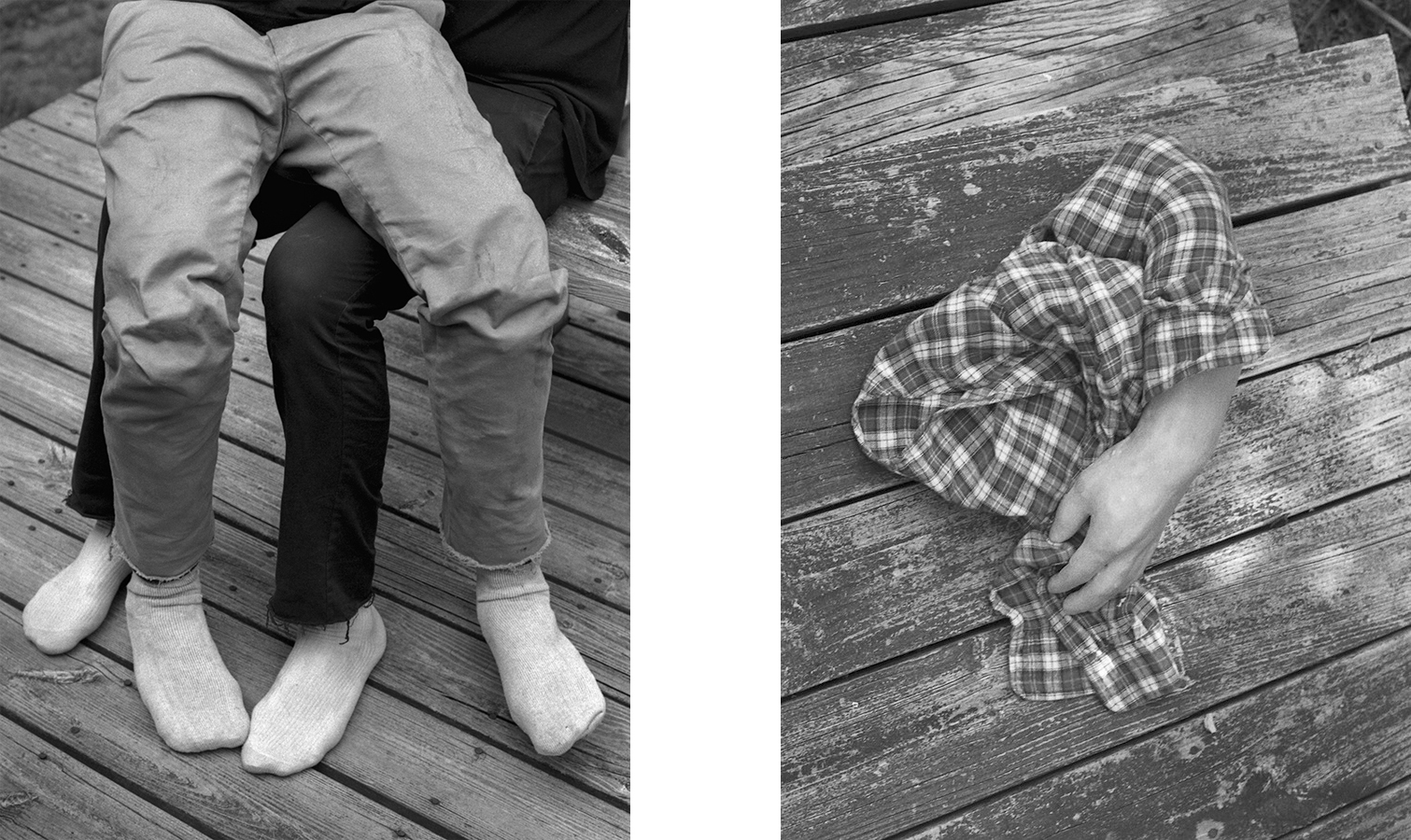
JH: They were a part of a show?
DH: Yeah, these were in the first show I did at JTT. They were a part of The Enthusiast and were sporadically hung. That’s a part of how I think about my work too, how they can be recycled, especially in photographs, because you don’t have to destroy it or anything.
JH: Do you destroy a lot of your works?
DH: No. There are parts of things, especially when I do more installation based works. For example, if I make a giant floor, I’ll cut that into pieces and reuse the material. Or if something is old and i realize it’s not sitting right, I’ll break it up and either rework it and use it as parts. Being able to do that is important. It’s important to me to be able to move between mediums a little bit. Most of the stuff I’ve ended up showing at least for the last couple of years have been full on sculptures.
JH: What do you mean by full on sculpture?
DH: These wood and plaster objects in a room. Drawing is really important to my practice too, and photographs and videos are some of the older things I would do. I’ve been trying to write short scenes that are almost like sculptures.
JH: Do you draw in the studio?
DH: No, I draw at home. It’s important to spread out what I do.
JH: There’s a different energy to the drawings compared to the sculptures. It’s the same subject, and similar formal qualities.

DH: They’re basically the same materials, too. The sculptures are finished with paste wax and milk paint pigment, and graphite, and the drawings are done with Q-tips with the same material. It gives them an old-fashioned illustrative quality.
JH: The scale is really important too, that you’re not doing these drawings the size of your sculptures.
DH: That would be interesting, but it wouldn’t have the same intimacy which is what I think is interesting about works on paper. Photographs, too. I print all my photographs really small, about 2 x 3 or 4 x 5. They vary based on my whims.
JH: It’s important that it happens that way. I think a lot of artists either have it down to a formula or they’re looking for a one which seems like the antithesis of what you’re working towards, or working as.
DH: Sometimes I fall into that and try really hard to get out of it. I need to be excited if I’m going to be doing this. I’ve actually tried and thought to myself ‘maybe I can make a full on series all at once’-
JH: A series as in the same size?
DH: Yeah, different variations of this thing. I’ll cut all the pieces, and assemble one and not want to make anymore. I understand why it works for other people, and it’s a way to elaborate on one idea, but for me, I like to work through an idea. It’s more fun to think ‘wow, that was a weird idea, I’m just gonna see what that looks like,’ or ‘I’ve never thought of that before, I’ll just make it. It doesn’t work out right away, ever, and I’m not trying to give the impression that I’m doing this flippantly.
JH: It goes back to what you were talking about before about the intimacy of working through something, and maybe after the first one, the intimacy isn’t there anymore.
DH: Sure, and I definitely enjoy my process. It’s also important to have a couple different things going at once- even right now, I have a figure I’m working on, and a door, and just whatever else I want to work on.
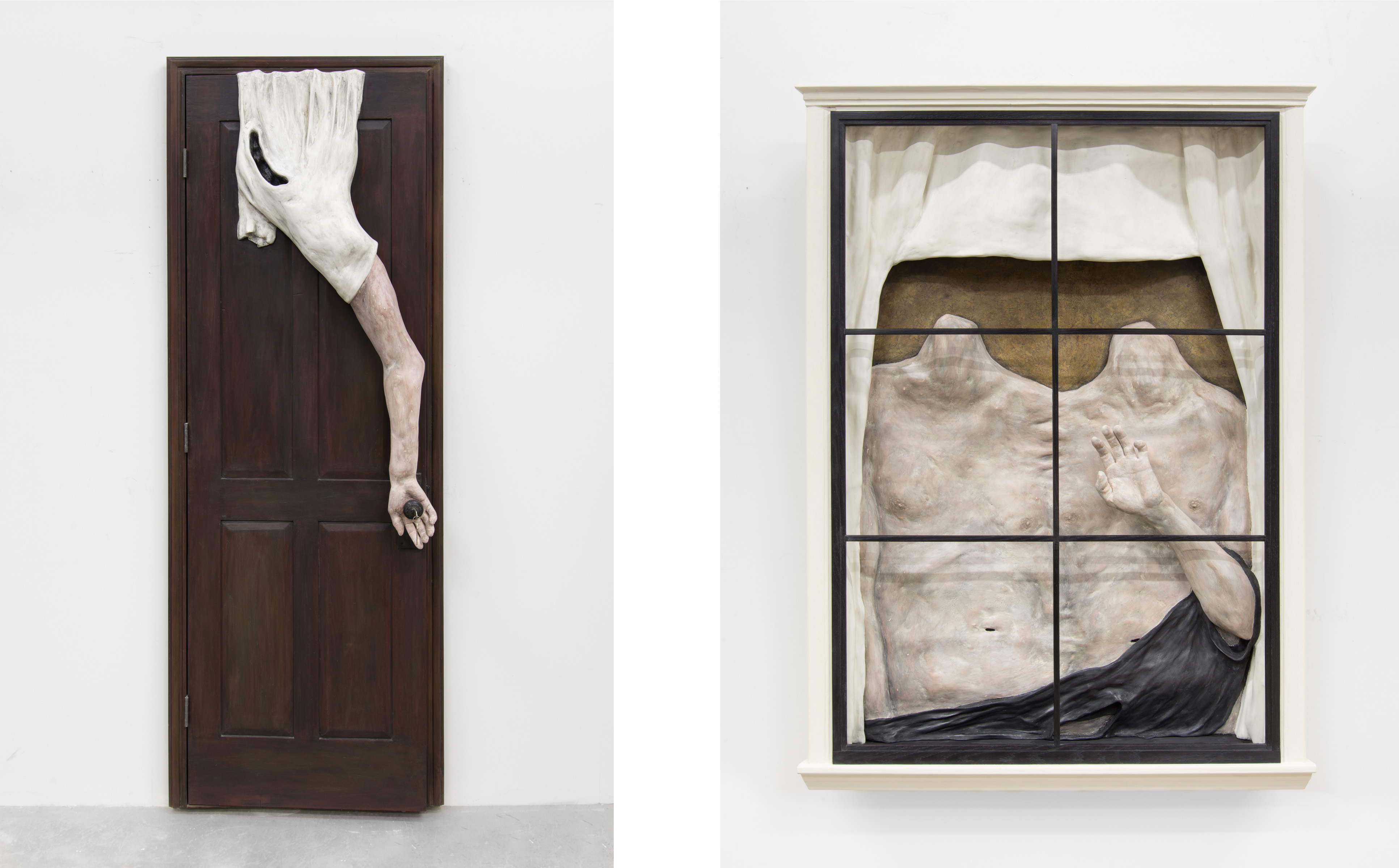
JH: When you make generic architectural features like moldings for your sculptures, in “The Listener” for example, do you make all those yourself?
DH: Yes, they’re all just 2 x 4’s that I cut down and shape on a table saw. Even the siding is a 2 x 4 cut at a slight angle so I get little slivers. That’s another thing; you have to work within your means. The materials don’t cost that much for me to get but the tradeoff is that I spend a lot of time. It’s interesting to think about that for different peoples practices. Sometimes it’s worth it to have someone else do something for you, but I like working, the labor. I like making a thing out of a thing that wasn’t supposed be that.
JH: Like how you wouldn’t want a siding made of 2×4’s in the real world.
DH: Exactly. And I could’ve just gone out and bought siding, but it would just look like I bought siding. I feel like when I make everything, it all has my hand in it, the way a drawing would. It makes things a little more cohesive. I’m not inserting my world on another world- I’m making the whole thing.
Although times where I use real hardware, or a real thing. For example, there’s a real pencil, or buttons- I could shape buttons out of clay, but that would be too much wobble- too much hand. I want there to be enough to tie it to the real world that the things I’m doing to it feel like something that came about in the real world. I just want it to be my version of it.
That’s what you were saying too- I don’t need it to be a rule saying everything is made by me, or only these things need to be. Sometimes it’s fun to make sometimes and sometimes sucks to make it, and those times, if it doesn’t change the piece, I use the real thing. A cast of an object vs the real object sometimes doesn’t matter for the piece. But sometimes, it works to make a cast, for example in this piece I Was Once a Deserted Room , I used a cast of a doorknob because it was reincorporated into a cast of my hand. If I used a real doorknob, it would just be a different kind of problem solving- not one that I am as interested in. There’s another example in this Ignore Him, where I made the scissors and the rug, and spent two evenings making the tassels for the end of the rugs. And that type of labor appeals to everyone- maybe not exactly tasslemaking but the absent minded labor that you can do and is satisfying.
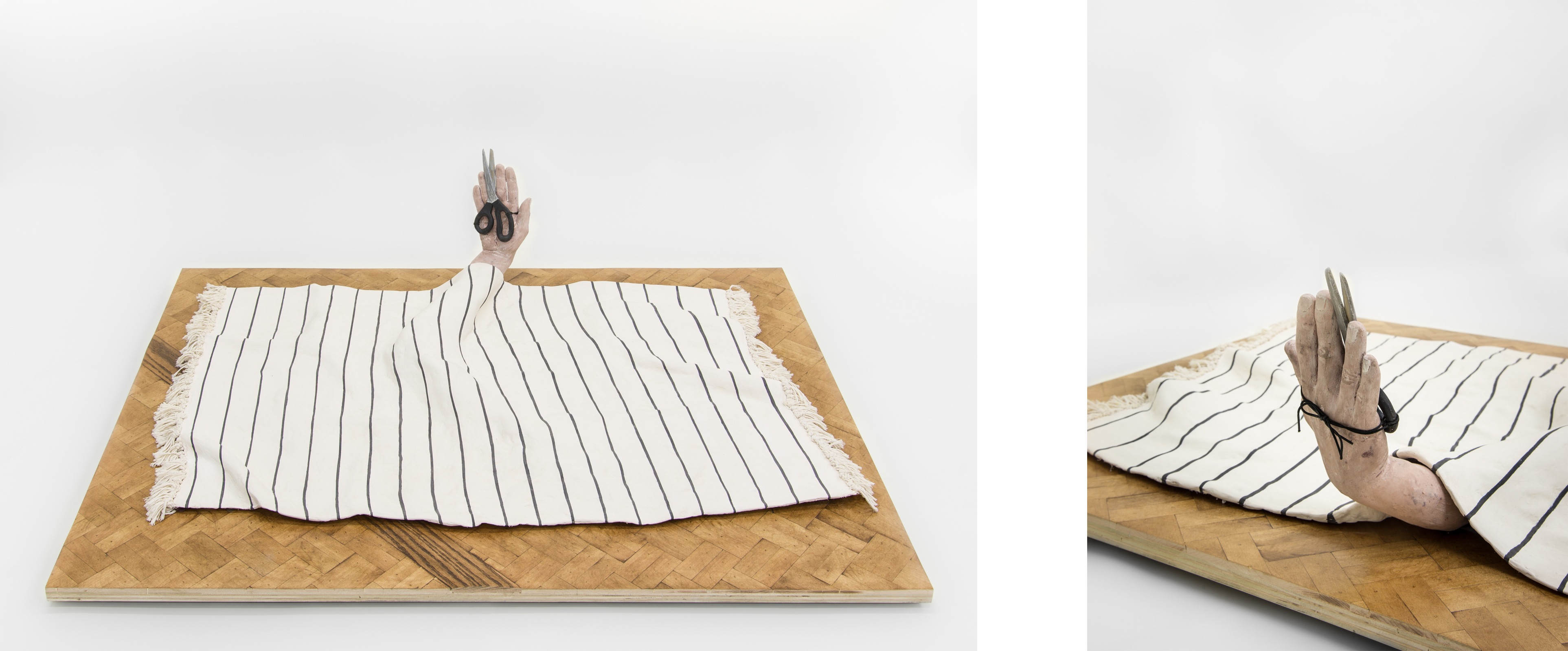
JH: How do you like working with JTT?
DH: It’s great. I’ve known them forever, they’re my best friends and they’re my family.
JH: It’s almost best case scenario for an artist.
DH: Yeah, but I don’t think that kind of relationship works for everyone. There’s tradeoffs. Some people don’t want to think about their gallerists’ feelings and want it to remain a strictly business transaction. It’s funny with JTT, because I started working for Jasmin as an art handler when she opened the gallery in 2012, so I finished sanding her ceilings and installed the first show. I worked for her for three years, and she offered me a show and fired me. It was great, it was kind of a ceremonial firing.
I like it that way, but for a while I didn’t know what to think of that. I kept asking myself ‘what does it mean to have this show at a gallery that I was an art handler at?’ I didn’t know what that relationship was.
JH: And that’s a pretty unique position too.
DH: I don’t think it happens a whole lot. I was scared at first that she felt like she owed me something, and that’s why I was offered the show. I’ve realized over time that it was not about that at all. I’m so grateful that it happened that way. It was really organic- I found people I liked, stuck with them, and now we’re all going together. It’s really great.
It was interesting too, because I was never searching out a gallery. I remember a lot of older artists asking me all the time- “where would you show if you could show anywhere?” and I would never have an answer.
JH: It’s kind of a bad question.
DH: It is, because it implies that you have a choice. And I’m sure some people have choices, but that’s not how I felt at the time. I’d never done a show at a ‘real’ gallery at that point. It was cool that Jasmin would come to my weird shows in Brooklyn after work and paid attention to what I was doing. It was really generous of her, but it was because we were friends, not because she came with the intention of being generous. That’s what feels good about the whole relationship. I trust these people. There’s a lot of people who are cynical of the whole gallery system, but there are good people.
JH: Does it still feel weird to you?
DH: A little bit, but in a cool way.
JH: Are you friends with a lot of the other artists?
DH: I became friends with a lot of these people art handling for them, like Charles Harlan and Borna Sammak. JTT is a family oriented gallery in that way. We all hang out, and that’s also something I don’t think happens very often. There’s definitely galleries that are like that, but in a general sense not as much.
JH: Was Jasmin an art major?
DH: Yeah, but I think she realized while she was in school that she was more interested in curating shows and facilitating other artists.
JH: I think half the people that go to art school realize they love art in a different way than making it. In my program for Art Administration, a lot of people were art majors, and said realized after the first critique that they didn’t want to be artists.
DH: That’s so funny. It’s a funny reaction and I totally get it, because I hated that stuff. I hated crits, I hated school. I’m talking about undergrad, I don’t have an MFA. I just thought it was all so stupid, but I was also really naive and stupid myself. I’ve gotten a lot out of it, obviously.
JH: Would you get an MFA?
DH: I don’t want one- it works well for certain types of people, but I’m pretty self-directed. I don’t have the money for that kind of stuff too. I know there are programs that will pay for it, but I’ve spent a lot of time crafting my life and to change all that up would be crazy. I do my share of research and learning on my own. And I have friends that I talk about it with, so I get to choose all the people that I get to go to my fake school with. It’s great.
JH: I think I’ve talked about everything I wanted to, but is there anything you want to add?
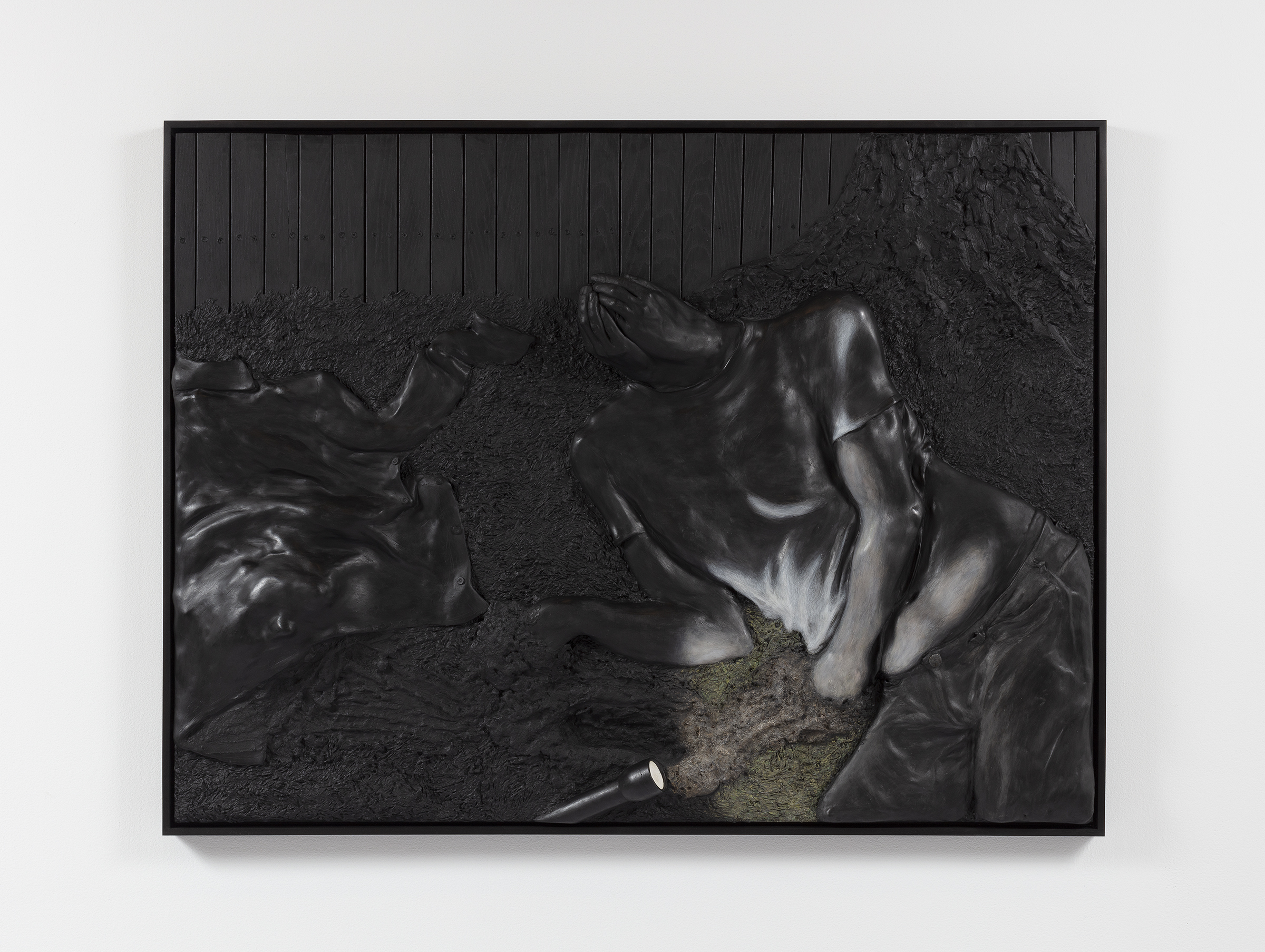
DH: One thing that I want to say is, and it’s way out of context now but we were talking about narrative in my work. I think the reason storytelling is important in my work is that I grew up in an AA household, my dad was a recovering alcoholic and drug addict. So growing up, your story really mattered. AA is all about people telling their stories.
JH: When you talked about growing up with horror movies, do you think you go back to those moments because there’s an aspect of comfort to the experience, and that acts as an object of comfort?
DH: I think that could be it, but that’s what I’m wondering for myself. I know I’m not the only person that feels this way, but I know there aren’t a lot of people that feel that way about horror. I’m wondering if it’s a genuinely useful thing. I think it is. But I think I do have to reckon with the fact that it is, like you said, an object of comfort for me. So that means I need to be very clear about what I mean. I don’t feel like I have a time limit on making that statement. That’s one of the things I’m trying to figure out.
JH: Do you still talk to your dad?
DH: Yeah! He helped me make The Architect. We built the plaster and lathe facade together, and he plastered it. We are good at working together. I grew up working with him- he was a clam digger and I worked on his boat. And when during the winters, he would refinish and restore antique furniture. In the most beautiful way, he didn’t show me how to do any of that stuff. He was a very good example of being a father figure that didn’t believe in having to know how to do those things in order to be a man. Or like sports, or act a certain way. He was very forgiving, and if I was interested in those things, he’ll gladly talk about it.
Working with him on his clam boat every summer was a really important experience for me as a teenager. I’m really grateful that I got to work on the water. It’s a weird thing, and it’s weird people that do it. There’s no boss, there’s no hours, you get as much money for as many clams you get.
JH: Walk me through a day of clamming.
DH: Some guys would go out super early in the morning, but I think that’s a confused idea because people think about fishing. But clams are just in the bottom, in the mud. The time of day doesn’t matter, except the tides. We would go out at nine, on his 18 foot boat, which is pretty small for two people working on it with the console, and the cull rack, which is where you dump the clams on, and sort the clams. That was my job, I was the cull boy, sorting which clams we could keep and which we had to put back.
I just remember being really impressed whenever my dad would make these sails with a tarp with a chain weight on the bottom, and an aluminum pole on the top that had a rope on a pulley system, and if there was a breeze, you would put a pole up as a mast, and with the pulley at the top, you would hoist the tarp up and make a sail. And if there wasn’t a breeze but a tide, you would throw the chain over the side of the boat, let the tarp sink, and it would make a sail underwater that would catch the tide under the boat. And my dad’s only knowledge on this was through just doing it. He was dyslexic, so he’d never read about any of this and it probably informs my practice on making things myself in that way. There’s all these rules about clamming where you have to do it very naturally, without a motor.
JH: For the sake of the clams?
DH: In the way that they didn’t want you to overclam
JH: Is there a limit?
DH: You can get 10 bushels a day, and a bushel is 400 littleneck clams. There were a couple years where we were getting 10 bushels a day, but it was after they sprayed for West Nile virus for the mosquitos in Long Island, and all of the runoff killed all the lobsters because lobsters share a lot of DNA with mosquitos. Then the clam population exploded because lobsters and crabs are major predators for clams. So there were two or three years where we would just go out for three hours a day and we’d hit the limit. And that was awesome, but now you’re lucky if you get two bushels a day.
That’s something I’m grateful for, because art is like that too. Sometimes it’s great, and sometimes it’s not but you can’t just stop. You definitely can’t predict anything. I’m just really grateful for having worked in that way. I think it set me up to be emotionally okay in this art world, because you just don’t know.
Dan Herschlein (b. 1989, Bayville, NY) received his BFA from New York University in 2010. He has exhibited in group shows including 10 years/ 100 sculptures, (Anonymous Gallery, Mexico City, MX, 2018), Spirit Chair, (BellaKvarter, Copenhagen, DK, 2018), NVV _ 2018, (Museum of Modern Art Dubrovnik, HR, 2018) and Dinner that night, (Bureau, New York, NY). He has also been featured in solo exhibitions at JTT Gallery, NY; 56 Henry, NY; AALA, LA; and Automata, LA.
The Architect, curated by Natalie Bell is on view at the New Museum windows until 01/06/2019.
Housewarming, a group exhibition at Nichelle Beuchene gallery, is on view until 12/09/2019.
